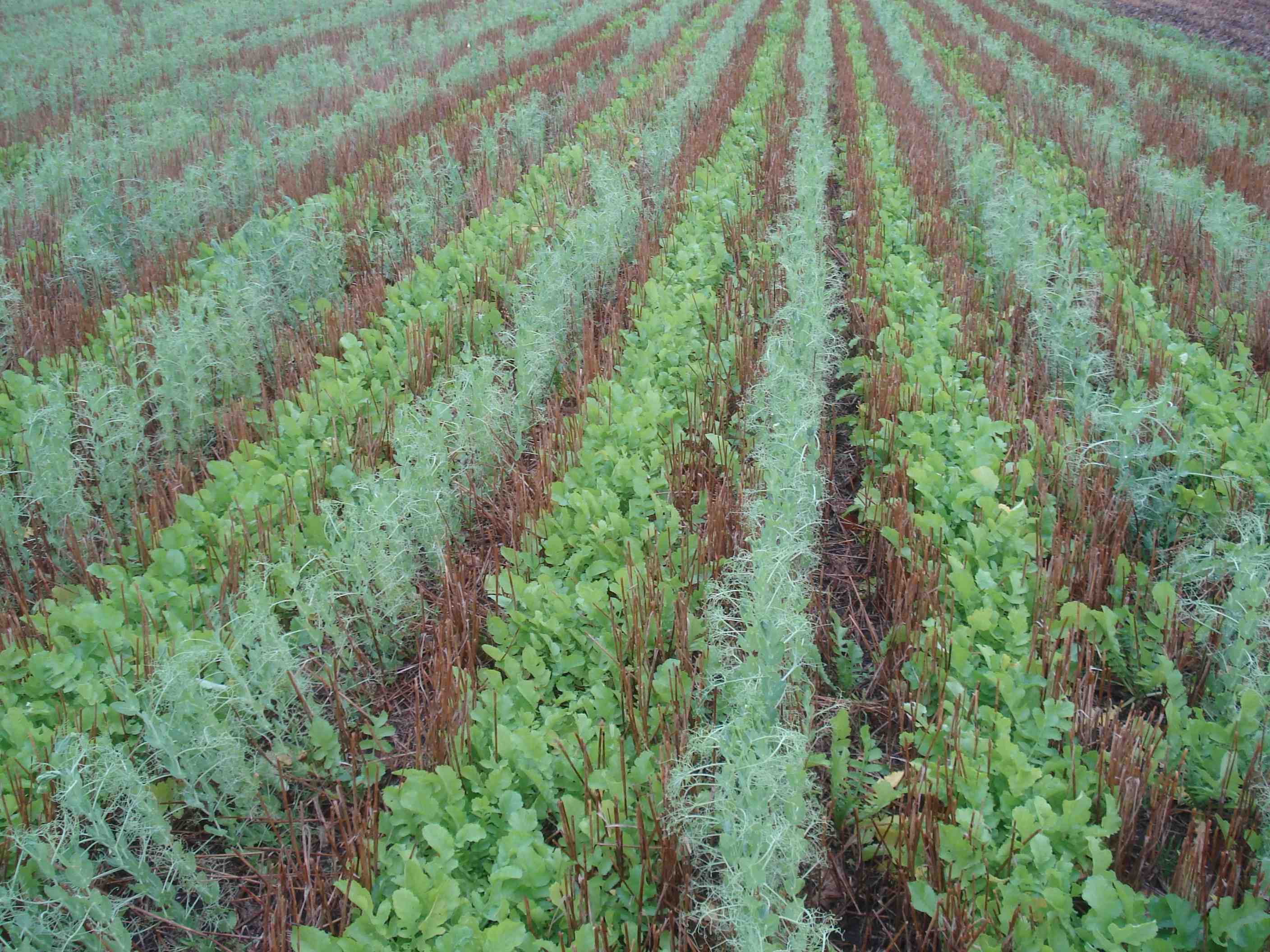Using forage radishes and field peas for "bio strip-till" produced the fifth and sixth-highest corn yields of 53 test plots in 2010 at the Conservation Cropping Systems Project, a no-till demonstration farm near Forman, N.D., says farm manager Kelly Cooper.

WORKING TOGETHER. Forage radishes and field peas grow in the fall of 2009 in a "bio strip-till" experiment at the Conservation Cropping Systems Project in North Dakota. Corn planted in these plots in 2010 were the fifth and sixth-highest yielding of 53 plots at the farm. (Photo from CCSP)
"We looked at bio strip-till to provide fracturing of the soil and allow better root penetration of the corn," Cooper says. "Bio strip-till can be an alternative to mechanical strip-tilling, which can be susceptible to gully erosion on rolling ground.
"That can happen if there's a 2- or 3-inch rain after corn is planted into strips made with a strip-till rig. The water can channel down through the strips. This seems to be more of an issue on rolling ground than on flat ground."
"Bio strip-till," or "bio drilling" uses forage radishes and other cover crops, instead of mechanical tillage from a strip-till rig, to create voids in the soil.
The idea is that the radish roots will loosen the soil, alleviate compaction and then die and decay. Farmers can then plant a crop into these voids during the following spring.
"Data suggests that bio drilling with cover crops like forage radish can substitute for expensive and energy-intensive deep ripping and other mechanical methods to alleviate the effects of soil compaction," says a University of Maryland publication on forage radishes that soils professor Ray Weil co-authored.
Top-Ranking Corn Yields
In one of the three plots with the radishes and field peas, much of the corn seeded in spring 2010 rotted due to water ponding from excessive rainfall, Cooper says.

Kelly Cooper
In the other two plots, the corn yields were the fifth- and sixth-highest of the 53 plots. "The best-yielding corn in 2010 was in a sprayed-out field of alfalfa," he says. "All of this shows that corn really does pretty well if you find the right cover crop."
The top yield of 206.9 bushels per acre came from a no-tilled rotation of spring wheat, winter wheat, alfalfa, alfalfa, corn and soybeans. Two of the three "bio strip-till" plots in a corn, soybean, cover crops and winter wheat rotation produced 189.7 and 182.1 bushels per acre.
Cooper says bio strip-till was an "all-out experiment" he learned from University of Maryland soil science professor Ray Weil, who works with cover crops. The radishes and field peas are part of the corn-soybean-winter wheat rotation on the CCSP farm in North Dakota.
"There is a risk of an allelopathic effect in planting corn after winter wheat because both are grasses," Cooper says. "But by seeding a cover crop like radishes or peas between the winter wheat and the corn, the corn only 'sees' the cover crop and not the wheat.''
By seeding cover crops after harvesting winter wheat in July, the green plants and growing roots will take up excess moisture, Cooper says. That won't happen if only dead winter wheat plants remain in the fields, or if fields are tilled black. And in black fields, salts will rise to the surface, which can create problems with salinity.
Seeding Cover Crops
In mid-August 2009, the farm sprayed glyphosate on the harvested winter wheat plots before seeding the radishes and the peas. And in September 2009, Cooper sprayed Select Max over the top to kill volunteer winter wheat.
Using RTK, Cooper seeded about 200,000 seeds per acre of forage radish — which he estimates weighed 8 to 10 pounds – with a John Deere 7200 planter with Kinze brush meters and soybean plates. It's the same planter the farm uses to no-till soybeans.
"We seeded the radish on 30-inch rows, with a spacing of a half-inch to 1 inch between each seed," Cooper says. "I slowed the planter down to 4 mph, but the population may have worked out to be 200,000 to 400,000 seeds per acre.
"We need to use sorghum plates instead of the soybean plates to accommodate the much smaller radish seed. Then I moved over 15 inches in the plots and planted the field peas between the radish rows."
Cooper says that by spring 2010, all of the radishes had decomposed.
"Due to the heavy seeding rates of the radishes, there weren't any big root voids," he says. "There were a few dead pea plants, but they didn't interfere with planting the corn."
With RTK, Cooper no-tilled corn into these three plots with a John Deere 7200, eight-row corn planter on 30-inch spacings. The plots are 60-feet wide by 200 feet long.
"The ground on one of the plots was fairly firm where we went over it with the planter to seed cover crops in the fall of 2009," Cooper says. "I got good seeding depth with the corn. The ground was firmer than in plots where we hadn't gone over them with a planter."
Cover-Crop Benefits
Using cover crops can stabilize the soil, minimize erosion and provide options for farmers using mechanical strip-till, Cooper says.
"You could seed cover crops in the fall and then strip-till in the fall or the spring," he says. "You could also strip-till in the fall, putting down phosphate and potash, then seed the cover crops. There's also the possibility of using some nitrogen to stimulate the radish crop."
Cooper tried bio strip-till again in later summer 2010, after harvesting winter wheat, but ran into problems with the radishes.
"There are a lot of different varieties of radish seed that are being sold," Cooper says. "You want radishes that are not going to go to seed quickly. What happened to us was that the radish bolted and we got woody foliage instead of big roots. But we're going to keep trying cover crops with strip-till."
He adds, "We're also looking at using an Amity two-disc drill, with RTK, to seed radish, placing the radish seed about 3 inches on either side of where we come back and plant corn in the spring. You could also do this with the Kinze Interplant system, seeding legume cover crops that would add some nitrogen."





